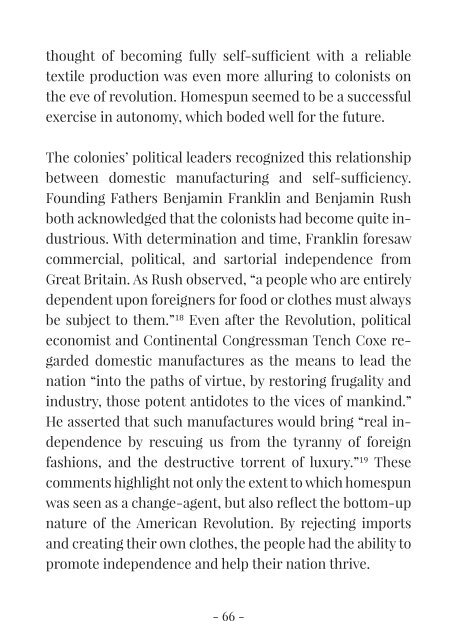The Fleece of Their Flock: Homespun & the American Identity
This interdisciplinary thesis project was researched, written, and designed by Jessica Vodnik and submitted in fulfillment of the Honors Senior Capstone requirement for the DePaul University Honors Program. Please do not copy, reproduce, or distribute without permission. Dr. Amy Tyson, Director, American Studies Dr. John Burton, Second Reader, History Undergraduate Honors Senior Thesis DePaul University, Chicago, IL May 10, 2015
This interdisciplinary thesis project was researched, written, and designed by Jessica Vodnik and submitted in fulfillment of the Honors Senior Capstone requirement for the DePaul University Honors Program. Please do not copy, reproduce, or distribute without permission.
Dr. Amy Tyson, Director, American Studies
Dr. John Burton, Second Reader, History
Undergraduate Honors Senior Thesis
DePaul University, Chicago, IL
May 10, 2015
Create successful ePaper yourself
Turn your PDF publications into a flip-book with our unique Google optimized e-Paper software.
thought <strong>of</strong> becoming fully self-sufficient with a reliable<br />
textile production was even more alluring to colonists on<br />
<strong>the</strong> eve <strong>of</strong> revolution. <strong>Homespun</strong> seemed to be a successful<br />
exercise in autonomy, which boded well for <strong>the</strong> future.<br />
<strong>The</strong> colonies’ political leaders recognized this relationship<br />
between domestic manufacturing and self-sufficiency.<br />
Founding Fa<strong>the</strong>rs Benjamin Franklin and Benjamin Rush<br />
both acknowledged that <strong>the</strong> colonists had become quite industrious.<br />
With determination and time, Franklin foresaw<br />
commercial, political, and sartorial independence from<br />
Great Britain. As Rush observed, “a people who are entirely<br />
dependent upon foreigners for food or clo<strong>the</strong>s must always<br />
be subject to <strong>the</strong>m.” 18 Even after <strong>the</strong> Revolution, political<br />
economist and Continental Congressman Tench Coxe regarded<br />
domestic manufactures as <strong>the</strong> means to lead <strong>the</strong><br />
nation “into <strong>the</strong> paths <strong>of</strong> virtue, by restoring frugality and<br />
industry, those potent antidotes to <strong>the</strong> vices <strong>of</strong> mankind.”<br />
He asserted that such manufactures would bring “real independence<br />
by rescuing us from <strong>the</strong> tyranny <strong>of</strong> foreign<br />
fashions, and <strong>the</strong> destructive torrent <strong>of</strong> luxury.” 19 <strong>The</strong>se<br />
comments highlight not only <strong>the</strong> extent to which homespun<br />
was seen as a change-agent, but also reflect <strong>the</strong> bottom-up<br />
nature <strong>of</strong> <strong>the</strong> <strong>American</strong> Revolution. By rejecting imports<br />
and creating <strong>the</strong>ir own clo<strong>the</strong>s, <strong>the</strong> people had <strong>the</strong> ability to<br />
promote independence and help <strong>the</strong>ir nation thrive.<br />
- 66 -


